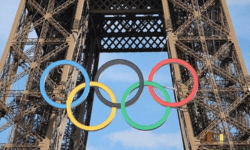
The Olympic Rings
The modern Olympics is replete with symbols, many of which are wrongly ascribed to the ancient games. The most obvious is the five interlocking Olympic rings, which were “invented” in 1913 by Pierre de Coubertin, then-President of the International Olympic Committee.
Some authors have ascribed the rings to an ancient inscription on a stone block from Delphi, but they are gravely mistaken. The inscribed stone block at Delphi was created for a German promotional film for the infamous 1936 Nazi Olympics. Likewise, the Olympic torch relay was never a symbol of the ancient Olympics, but, again, we owe that ritual to the Nazis. Ughh. If you would like to learn more about the myths surrounding the Olympic Games we recommend this article.
Olympic symbols – irrespective of their origin – are hugely important for the promotion and economics of the Olympic games. The International Olympic Committee and its affiliates zealously guard them. For example, in the United States, Congress enacted the Ted Stevens Olympic and Amateur Sports Act in 1978 (amended 1988), which bestows exclusive use of “United States Olympic and Paralympic Committee,” the symbol of the International Olympic Committee (the five interlocking rings symbol), the emblem of the Committee, and the words ““Olympic”, “Olympiad”, “Citius Altius Fortius”, “Paralympic”, “Paralympiad”, “Pan-American”, “Parapan American”, “America Espirito Sport Fraternite”, or any combination of those words.” It also provides for civil actions against the infringers pursuant to the Trademark Act of 1946.
So, don’t even think about using any of those terms or symbols without prior permission (i.e., purchase a license) from the Olympic Committee. Even the United States Supreme Court has weighed in on the subject. In San Francisco Arts & Athletics, Inc. versus US Olympic Committee, it affirmed a permanent injunction against the company’s use of the term “Gay Olympic Games.” We count 158 active registered trademarks owned by the International and United States Olympic Committees.
Stay away from using images and videos from Olympics
If you are considering marketing Olympics related merchandise, stay away from using images or videos of the Olympic games or the participating athletes. Not only would using images or videos potentially infringe copyrights but they might also infringe the participants’ rights of publicity. Even posting Olympics related content on social media might land you in a heap of trouble.
Ambush Marketing
The bottom line is that marketers have to be creative if they want to avoid the cost of licensing Olympic symbols. One such approach is referred to as “ambush marketing.” This is where a company attempt to associate itself with a brand or event for which it does not have the official sponsorship. For example, running ads near the event or discussing it in social media without inferring sponsorship. One source identifies four types of ambush marketing:
Predatory ambushing: This is when a brand intentionally targets other brands to steal attention and customers.
Coattail ambushing: With coattail ambushing, a brand hitches a ride on the popularity of the event without being an official sponsor.
Property or trademark infringement: Some brands use logos, symbols, or words belonging to their competitors to gain market share and make consumers believe they’re official event sponsors.
Self-ambushing: This happens when an official sponsor goes beyond the rules of their sponsorship agreement. For instance, they might give away free swag at the event, even if they’re not allowed.
Ambush by association: Ambush by association is when brands use promotional tactics to make it appear as though they’re associated with the event even though they’re not official sponsors. This can involve using images or themes associated with the event that are not trademarked, allowing the brand to benefit from the event’s popularity without explicit endorsement or sponsorship.
Values ambush: Instead of directly referencing the event, a brand might align its marketing campaigns with the values or themes associated with the event. For instance, promoting athleticism or sportsmanship without mentioning the event itself.
So, there are creative ways of avoiding licensing fees and other costs associated with promoting and sponsoring big events. However, be aware of the legal and ethical risks and ensure that your approach is vetted by competent intellectual property counsel.
— Adam G. Garson, Esq.

